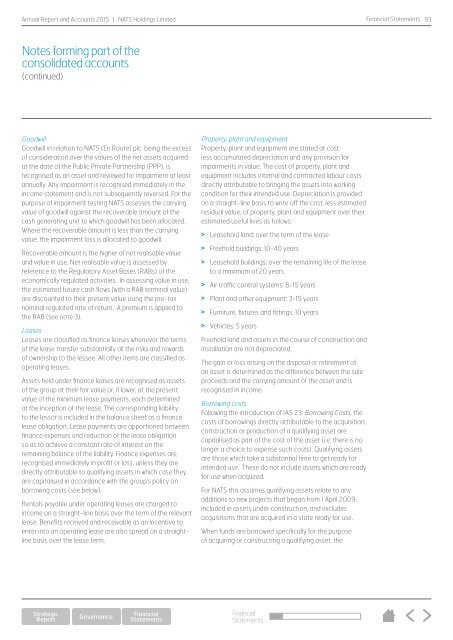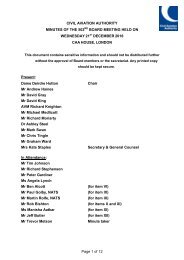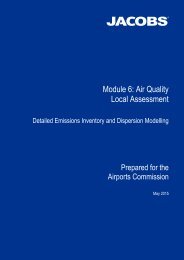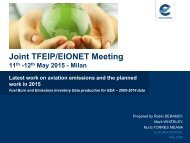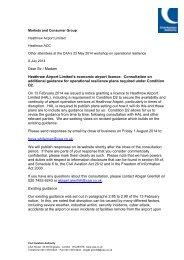NATS-Annual-Report-2015
NATS-Annual-Report-2015
NATS-Annual-Report-2015
You also want an ePaper? Increase the reach of your titles
YUMPU automatically turns print PDFs into web optimized ePapers that Google loves.
<strong>Annual</strong> <strong>Report</strong> and Accounts <strong>2015</strong> | <strong>NATS</strong> Holdings Limited<br />
Financial Statements 93<br />
Notes forming part of the<br />
consolidated accounts<br />
(continued)<br />
Goodwill<br />
Goodwill in relation to <strong>NATS</strong> (En Route) plc, being the excess<br />
of consideration over the values of the net assets acquired<br />
at the date of the Public Private Partnership (PPP), is<br />
recognised as an asset and reviewed for impairment at least<br />
annually. Any impairment is recognised immediately in the<br />
income statement and is not subsequently reversed. For the<br />
purpose of impairment testing <strong>NATS</strong> assesses the carrying<br />
value of goodwill against the recoverable amount of the<br />
cash generating unit to which goodwill has been allocated.<br />
Where the recoverable amount is less than the carrying<br />
value, the impairment loss is allocated to goodwill.<br />
Recoverable amount is the higher of net realisable value<br />
and value in use. Net realisable value is assessed by<br />
reference to the Regulatory Asset Bases (RABs) of the<br />
economically regulated activities. In assessing value in use,<br />
the estimated future cash flows (with a RAB terminal value)<br />
are discounted to their present value using the pre-tax<br />
nominal regulated rate of return. A premium is applied to<br />
the RAB (see note 3).<br />
Leases<br />
Leases are classified as finance leases whenever the terms<br />
of the lease transfer substantially all the risks and rewards<br />
of ownership to the lessee. All other items are classified as<br />
operating leases.<br />
Assets held under finance leases are recognised as assets<br />
of the group at their fair value or, if lower, at the present<br />
value of the minimum lease payments, each determined<br />
at the inception of the lease. The corresponding liability<br />
to the lessor is included in the balance sheet as a finance<br />
lease obligation. Lease payments are apportioned between<br />
finance expenses and reduction of the lease obligation<br />
so as to achieve a constant rate of interest on the<br />
remaining balance of the liability. Finance expenses are<br />
recognised immediately in profit or loss, unless they are<br />
directly attributable to qualifying assets in which case they<br />
are capitalised in accordance with the group’s policy on<br />
borrowing costs (see below).<br />
Rentals payable under operating leases are charged to<br />
income on a straight-line basis over the term of the relevant<br />
lease. Benefits received and receivable as an incentive to<br />
enter into an operating lease are also spread on a straightline<br />
basis over the lease term.<br />
Property, plant and equipment<br />
Property, plant and equipment are stated at cost<br />
less accumulated depreciation and any provision for<br />
impairments in value. The cost of property, plant and<br />
equipment includes internal and contracted labour costs<br />
directly attributable to bringing the assets into working<br />
condition for their intended use. Depreciation is provided<br />
on a straight-line basis to write off the cost, less estimated<br />
residual value, of property, plant and equipment over their<br />
estimated useful lives as follows:<br />
> Leasehold land: over the term of the lease<br />
> Freehold buildings: 10-40 years<br />
> Leasehold buildings: over the remaining life of the lease<br />
to a maximum of 20 years<br />
> Air traffic control systems: 8-15 years<br />
> Plant and other equipment: 3-15 years<br />
> Furniture, fixtures and fittings: 10 years<br />
> Vehicles: 5 years<br />
Freehold land and assets in the course of construction and<br />
installation are not depreciated.<br />
The gain or loss arising on the disposal or retirement of<br />
an asset is determined as the difference between the sale<br />
proceeds and the carrying amount of the asset and is<br />
recognised in income.<br />
Borrowing costs<br />
Following the introduction of IAS 23: Borrowing Costs, the<br />
costs of borrowings directly attributable to the acquisition,<br />
construction or production of a qualifying asset are<br />
capitalised as part of the cost of the asset (i.e. there is no<br />
longer a choice to expense such costs). Qualifying assets<br />
are those which take a substantial time to get ready for<br />
intended use. These do not include assets which are ready<br />
for use when acquired.<br />
For <strong>NATS</strong> this assumes qualifying assets relate to any<br />
additions to new projects that began from 1 April 2009,<br />
included in assets under construction, and excludes<br />
acquisitions that are acquired in a state ready for use.<br />
When funds are borrowed specifically for the purpose<br />
of acquiring or constructing a qualifying asset, the<br />
Financial<br />
Statements


